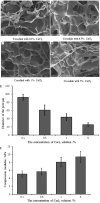3D Printing of Layered Gradient Pore Structure of Brain-like Tissue
- PMID: 34286148
- PMCID: PMC8287709
- DOI: 10.18063/ijb.v7i3.359
3D Printing of Layered Gradient Pore Structure of Brain-like Tissue
Abstract
The pathological research and drug development of brain diseases require appropriate brain models. Given the complex, layered structure of the cerebral cortex, as well as the constraints on the medical ethics and the inaccuracy of animal models, it is necessary to construct a brain-like model in vitro. In this study, we designed and built integrated three-dimensional (3D) printing equipment for cell printing/culture, which can guarantee cell viability in the printing process and provide the equipment foundation for manufacturing the layered structures with gradient distribution of pore size. Based on this printing equipment, to achieve the purpose of printing the layered structures with multiple materials, we conducted research on the performance of bio-inks with different compositions and optimized the printing process. By extruding and stacking materials, we can print the layered structure with the uniform distribution of cells and the gradient distribution of pore sizes. Finally, we can accurately print a structure with 30 layers. The line width (resolution) of the printed monolayer structure was about 478 mm, the forming accuracy can reach 97.24%, and the viability of cells in the printed structure is as high as 94.5%.
Keywords: 3D bio-printing; Brain-like model; Integrated cell printing/culture equipment; Layered gradient structure.
Copyright: © 2021 Pei, et al.
Conflict of interest statement
We have no financial and personal relationships with other people or organizations that can inappropriately influence our work, there is no professional or other personal interest of any nature or kind in any product, service, and/or company that could be construed as influencing the position presented in, or the review of, this article.
Figures









Similar articles
-
3D printing of layered brain-like structures using peptide modified gellan gum substrates.Biomaterials. 2015 Oct;67:264-73. doi: 10.1016/j.biomaterials.2015.07.022. Epub 2015 Jul 14. Biomaterials. 2015. PMID: 26231917
-
Engineering of brain-like tissue constructs via 3D Cell-printing technology.Biofabrication. 2020 May 12;12(3):035016. doi: 10.1088/1758-5090/ab7d76. Biofabrication. 2020. PMID: 32143204
-
Printability of Double Network Alginate-Based Hydrogel for 3D Bio-Printed Complex Structures.Front Bioeng Biotechnol. 2022 Jul 8;10:896166. doi: 10.3389/fbioe.2022.896166. eCollection 2022. Front Bioeng Biotechnol. 2022. PMID: 35875487 Free PMC article.
-
Review of 3D-printing technologies for wearable and implantable bio-integrated sensors.Essays Biochem. 2021 Aug 10;65(3):491-502. doi: 10.1042/EBC20200131. Essays Biochem. 2021. PMID: 33860794 Review.
-
Three-Dimensional (3D) Printing in Cancer Therapy and Diagnostics: Current Status and Future Perspectives.Pharmaceuticals (Basel). 2022 May 27;15(6):678. doi: 10.3390/ph15060678. Pharmaceuticals (Basel). 2022. PMID: 35745597 Free PMC article. Review.
Cited by
-
Bioprinting of 3D Functional Tissue Constructs.Int J Bioprint. 2021 Jun 22;7(3):395. doi: 10.18063/ijb.v7i3.395. eCollection 2021. Int J Bioprint. 2021. PMID: 34286157 Free PMC article. No abstract available.
-
Optimization of 3D Printing Parameters of Biodegradable Polylactic Acid/Hydroxyapatite Composite Bone Plates.Int J Bioprint. 2021 Dec 17;8(1):490. doi: 10.18063/ijb.v8i1.490. eCollection 2022. Int J Bioprint. 2021. PMID: 35187281 Free PMC article.
References
-
- Muming Pu BX. Nao Ke Xue Yu Lei Nao Yan Jiu Gai Shu. [Brain Science and Brain-Inspired Intelligence Technology] J Chin Acad Sci. 2016;31:725–36.
-
- Xiong Y, Mahmood A, Chopp M. Animal Models of Traumatic Brain Injury. Nat Rev Neurosci. 2013;14:128–42. https://doi.org/10.1038/nrn3407. - PMC - PubMed
-
- Huh D, Hamilton GA, Ingber DE. From 3D Cell Culture to Organs-on-Chips. Trends Cell Biol. 2011;21:745–54. https://doi.org/10.1016/j.tcb.2011.09.005. - PMC - PubMed
-
- Imamura Y, Mukohara T, Shimono Y, et al. Comparison of 2D- and 3D-Culture Models as Drug-testing Platforms in Breast Cancer. Oncol Rep. 2015;33:1837–43. https://doi.org/10.3892/or.2015.3767. - PubMed
-
- Tian XF, Heng BC, Ge Z, et al. Comparison of Osteogenesis of Human Embryonic Stem Cells within 2D and 3D Culture systems. Scand J Clin Lab Invest. 2008;68:58–6. https://doi.org/10.1080/00365510701466416. - PubMed
LinkOut - more resources
Full Text Sources
Other Literature Sources
